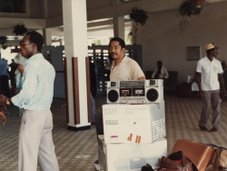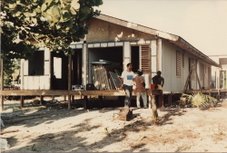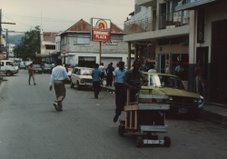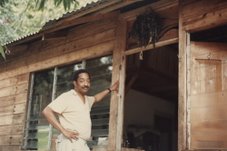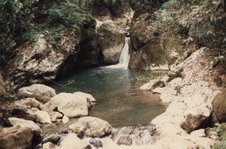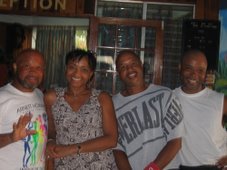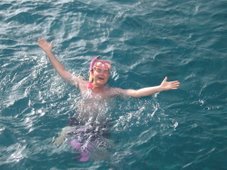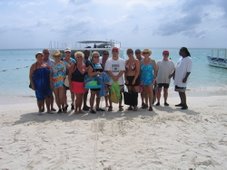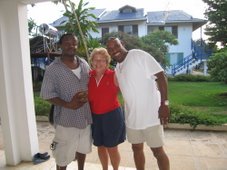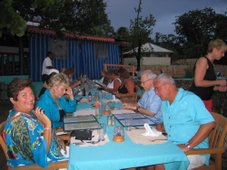


Our Air Jamaica flight to
Habana was aboard a new Airbus 320 and I noticed a number of attractive young, women of color in the rows ahead of me. They spoke Espanol and I notice one was shouldering an alto saxophone case, so I reasoned that it was a Cuban women’s band returning from a performance in
Jamaica.
The flight to Habana took one hour, three minutes and we were received at
Jose Marti’ International’s new airline terminal; open just one year. It looked as nice as any new terminal that I’ve seen in Europe or the U.S. We took our place in the extremely slow immigration lines.
This was the fourth time that I had been in a Cuban airport, so I wasn’t distracted by the green uniforms of government security personnel, army or police officers. No one seemed stressed, suspicious of me or anyone else.
There was one fellow American, a man in his late fifties, ahead of me that seemed to be having an unusually difficult time clearing the immigration window. He was halted on the wrong side of where he wanted to be and my party preceded ahead of him. I asked what his holdup was and he blurted out “Ah, those fuckin’ Cubans...., blah, blah, blah.” Evidently he was trying to get to Costa Rica, through Cuba and something was amiss, but it seemed that his hostile attitude was also a reason for his delay.
When I reached the window, the young female officer began speaking to me in Espanol, but I said “Habla Ingles? (Do you speak English?). She the asked me my reason for visiting. I told her that I was a musician and I was going to find
Irakere, the national band, and that I was a friend of
Chu Chu Valdes, their pianist and leader. Her eyes began to smile as she quickly stamped my forms and we wished each other well. I breezed through customs in less than sixty seconds due to my musical language.
There was plenty of help to get us to our transfer bus and the only delay of our whole vacation was when it took an hour for us to leave the parking lot. Evidently the bus was awaiting passengers on other flights, but I took the time to read and look out at the vintage autos in the parking lot.
Our route to Central Habana was not the one I was familiar with when I made this trip in 1994. This bus ride took us through many neighborhoods and I saw hundreds of faces of school children, young and old on the streets in the late afternoon.
OSU professor
Tony Mendoza showed me pictures of his family home from his book, “A Cuban Returns,” and I swore that I saw it on the ride in. His family had been well to do ranchers and government employees before the 1959 Cuban revolution. When he returned in 1995, he found that the house that he grew up in was still a government house. Like few of Habana’s homes or grand buildings, his family’s home had been well preserved and kept in diplomatic condition.
Our bus delivered passengers to hotels in the
Miramar District, west of Central Havana. The first hotels we arrived at were the
Neptune, Melia Cohiba, the Nacional and finally, at 5:15 p.m., we embarked at the
Libre, former the
Havana Hilton. The Libre was built in the 1950’s and when
Fidel Castro’s ragged army marched into an unresistant Habana on January 1, 1959, they took up residence in the Libre.
The hotel was beautifully restored and operated by a Spanish hotel company,
Tryp. I had resided at a Tryp hotel in Barcelona in June and was happy to find that I was in the lap of luxury. Everything worked, was modern and met the standards of a four star international hotel. My previous residence in
Old Habana was the
Hotel Plaza and I remember needing to bring my own wash clothes, salt, mustard and hot water. Not this time.
My patio balcony opened to view the ocean and the drive that runs along it called the
Malecon. I had
Habana Bay, Castle Morro and
Ft. Habana in the near distance and I noticed a cargo ship anchored off the coastline. I was later to find out that this ship had run aground two weeks earlier and was stranded in that spot.
My party’s habit was to rendevouz In the bar within an hour of arriving. The Libre’s bar and lobby was spacious, luxurious and a very inviting place to people watch. There was a grand piano and the female pianist,
Caridad Juban, seemed to spend more time wandering the room to market her products; discs and tapes. Talk about an easy gig.
During one of our four evenings, I brought my trumpet down to see if Señora Juban and I could find some common musical ground. We tried to play
The Girl From Ipanema, and I couldn’t follow her arrangement. She pulled a piece of traditional music and played the line for me. I tried to sight read, transpose and get a feel for the melody but stumbled. I pulled a score of songs out of my bag and played the melody for her but she could not contribute an accompaniment. So I put my horn back in my case and my tail between my legs. No common ground.
Warren, my birthday brother, was the master of the Libre’s lounge. If we set our rendevouz for six p.m., he would have the first bottle of Spanish champagne ordered and on ice by that time. He and I got into a nice rhythm of sipping, people watching and speculating on when the women folk in our party would finally arrive. We practice being unhurried, unstressed and on vacation.
The group decided to have our first Cuban meal on the twenty-fifth floor of our hotel to enjoy the legendary 360 degree view that the beautiful room was famous for. We arrived at seven p.m., just as the doors were being unlocked and were their first customers of the day.
Warren ordered the wine, we perused the menu and I ordered smoked salmon, which was served cold, with onion. I thought the entree was out of this world. My friends relished their meals and we spent nearly three hours enjoying the place to ourselves.
Before we left, the room started to fill with dinner guests and a musical quintet set up and began to entertain. Two women singers and three men, with two guitars and a string bass, were called the
Fusion Five. They sold us a cassette during their intermission and it proved to be the best music that we brought back with us.
After a long day, a large meal and several tall bottles, we descended to our rooms on the seventh floor and sleep. We had a tour bus coming for us at nine a.m. I logged notes about a beautiful day and passed out to sweet and comfortable dreams.
Fri.11/5, I awoke at first light, 6 am., as is my custom when I’m in the islands. I was in the Havana Libre Hotel’s second floor cafeteria at 6:45 am, some minutes before the doors for breakfast were opened.
Breakfasts in Havana are not usually pretty. When I recall breakfast in the Hotel Plaza in 1994, I remember strangely colored scrambled eggs and pinkish yogurt as Havana’s bad food at it’s worst. At the Libre, it’s at least, not ugly. Cold pancakes and French toast and fresh fruits are not as hard on the eyes.
I hooked up with my companions, who were bright eyed after their first night on Cuban soil (or should I say spoil), and we waited the customary half hour for our 9 am. bus tour; part of our $600.00 package tour.
Our city tour guide,
Francisco took our vouchers at 9:30 am. And every seat in the midsized bus was filled with Spaniards, Venezuelans, Germans and Americans, so I unfolded an aisle seat next to a greying but vibrant Venezuelan señora, who appeared to be touring with a party of single women of all ages.
Francisco was in his early thirties and he furiously worked his audience of twenty in two languages, for the Hispanics and Anglos. He knew the city well and talked continuously about the many sites that we saw as we traveled down the Malecon to Hotel Plaza, to pick up even more tourists. We passed the
Museum of the Revolution, with its display of vintage war machines, the Prado; a premier boulevard for pedestrian traffic in Centra Havana, and
Hotel Inglaterra, the hotel that is on the bottom end of package tour pricing for a good reason.
Our guides aimed the bus towards the oldest sites in Havana, Castle Morro and Fort Havana, founded in the early sixteenth century in a deep port that protected ships from tropical storms and pirates. We parked a short walk from the
Plaza de Armas. I remembered this local from my first trip in 1994 because of the numbers of booksellers that greet tourists and create many people’s first impressions of Havana, Cuba, after the airport and hotel food. I gave a seller thirty dollars for a small and obviously vintage-turn-of-the-century book of historic sites that was in good condition.
The Plaza de Armas is a beautiful green space surrounding a fountain, statues, old street lamps and the walkways lead past the structures that have seen five centuries of heat and storms; tropical, political, economic and social. Francisco led his large party through a former city hall and past a beautifully restored hotel that Papa Hemingway called home.
One of the first persons that I saw in the Plaza was an aging, but happy man dressed in a clownish red jacket, baggy yellow pants with huge black dots, a gold top hat and face paint, carrying an oversized, homemade mockery of a camera. Of course, being an entertainer, I was attracted to him. I palmed him some dead American presidents and I got some of my favorite photos that I entitled “Two Clowns in Havana.”
A real treat was going through an apothecary-pharmacy museum, because a vivid memory of a working apothecary that I walked past in 1994, with its antique jars full of ingredients and the pharmacist’s use of a mortar and pestle. This new site was truly a museum, complete with a case containing a human skeleton and it wasn’t the plastic kind, like in college anatomy displays. Our guide had fun sharing this museum with us.
One episode in our walk through old Havana took us and hundreds of other tourists across a street being blacktopped by a government street crew. There were no barriers, guards or warnings that your shoes were about to be blindsided by a tar explosion. I remember a family of Japanese tourists dancing through the ten foot wide path of fresh, black goo right behind me. “Welcome to Havana. Have a nice day!”
One of my friends noticed a young man on crutches wearing a sporty hat embroidered with the name
“Arnet.” I walked over, introduced myself and we conversed in our two languages. He was from Santiago, the regional capital at the southeastern end of Cuba, six hundred miles away. I gave him some dollars for a drink and he gave me his address and a new coin, featuring the likeness of
Che Guevera, the hero of the Cuban revolution.
In time, our path opened up into
Cathedral Square and the Jesuit church building dating back to 1777. Francisco spent a few minutes to briefing us on the success of the historic landmarks restoration project started a few years earlier that had become a financial success, bringing new life to old hotels and mansions.
Cathedral Square didn’t seem radically refreshed from my visit five summers previously. It did have a slightly different look of a concert-performance stage in front of the church, loudspeaker scaffolding and lighting cables draping the pavement in front of the cafe. The cafe was the site of my most wonderful moments during trip one, because it was here that I played with the cafe band and an audience of over a hundred, crowding around the bandstand within minutes as I played the blues on a borrowed trumpet.
We sat for lunch, tuna and beer, and before I got to the second half of my sandwich, I was on the bandstand introducing myself to the trumpeter,
Ivan. He had a warm, wonderful tone and technique that was classically the sound of Afro-Cuban trumpet. I was drawn next to him with my trumpet in hand, hoping that some of his sweet sound would just infect my instrument. It didn’t.
I really didn’t hold my own with the band,
Salsatica, that session and spent most of the time playing maracas instead of horn.
After posing for photos with three beautiful señoritas in colorful traditional Spanish dresses with scarfs and fans, we left Cathedral Square to make a noon bus departure, walking past an enormous craft market that was jammed so tight with vendors that it was a hesitant shopper’s nightmare. I found a couple of very cheap, slender, wooden statues that had evaded me on my first trip and paid a mere three dollars.
The bus rolled out of Old Havana towards the Capitol Building, where we made a five minute photo stop. We continued towards the
Plaza of the Revolution which passed the parts of Central Havana that haven’t had the blessings of the landmarks foundation, the government or Mother Nature. As we rolled passed miles of weathered neglect, broken signs, torn awnings, unrepaired architecture and the thousands of people who existed in this heap, Francisco’s running commentary urged us to use our imaginations to picture how beautiful the city had been. Our imaginations worked really hard.
We drove past the sixty-five acre
Columbus Cemetery that resembled New Orleans’ famous above ground burial fields, St. Louis Cemetery. He told us that a million plots were contained in the
graveyard that opened in 1865.
The Plaza of the Revolution was another fifteen minute photo stop in a wide open spot with few cars parked. The handsome image of Che was towering over the Plaza in a stunning metal line sculpture that seemed to stand ten stories and one of the few extension trucks that I saw in the entire city was attending to service on Che’s image. Got to keep the revolutionaries looking good.
After the Plaza of the Revolution, the bus made the rounds through the neighborhoods Miramar and Vedado, returning tourists to their hotels. Our party of five freshened and made a date to catch a cab to
La Casa for our first meal in a paladare; a private home accepting dinner guests.
La Casa came with a high billing from June, 1999’s
Cigar Aficionado Magazine and our cab drivers delivered us to the restaurant that was located in a 1960s era deco-modern neighborhood of arty suburban homes. We were in for a three hour dining extravaganza on a patio that had caged birds, a hanging garden, a waterfall, live turtles and lots of great food and drink. The specialty of the house was pico-pico (seafood hor d’overves) and “Chicken Gordonbleu,” in honor of tour host,
Manolo Robainas.
We had the place to ourselves most of the evening, later meeting a group of expatriate Cuban businessmen who led a group of Americans from Louisiana and Alabama. When we mentioned our roots in Ohio, one of the Cuban gentlemen asked if we knew Congressman
Louis Stokes from Cleveland, who he had hosted during an official visit to Havana. Warren, my birthday buddy and former secretary of commerce for Ohio during the 1980s, was acquainted with Congressman Stokes. The Cuban gentleman said he had also hosted
Dizzy Gillespie’s several musical trips to the island.
Our dinner at La Casa was first class and they proudly had their page from Cigar Aficionado beautifully framed. Señor Robainas autographed our copy and accepted our payment. Our taxis were waiting to deliver us back to the warmth of our beds at the Havana Libre Hotel. An excellent conclusion to a first full day in the city.
Sat. 11/6; Each night that I slept in the Havana Libre Hotel, I slept good. I had stayed in a Tryp hotel, the
Presidente, when I visited Barcelona in June, 1999 on my college graduation tour.
Spanish hotels define international class and many have a unique feature that controls the electrical service to the room. After unlocking the room door with the electronic key card, you slide the card into a slot next to the door, where the light switch is usually located.
When the card enters the slot, it triggers a switch that controls all the electronics in the room, except for the refrigerator. When when leaving the room, you immediately know where your key is and upon removing it, all the rooms lights and television are shut down. The hotel saves thousands of dollars on electrical service charges.
When my gang of five American tourists met after Saturday morning breakfast, we walked five blocks to the
Hotel Nacional for a brief tour. The Nacional was the first choice with our
Caribic Vacations package tour from
Montego Bay, Jamaica, but our travel agent informed us that it had been over-booked and we were being bumped to a better hotel for the same price; a sweet move.
The Nacional has been the pride of Havana since it was built in the 1930s and it was the ultimate in luxury and personal service for government officials, businessmen, the rich and the notorious for most of it’s first fifty years. We headed straight for the gardens and lawns that viewed the Gulf of Mexico, where we read historic plaques and saw huge cannons that had last fired thirty years before the Nacional was built. The guns defended Havana from the invading U.S. Navy in 1898’s Spanish American War.
It began to rain as we viewed the ocean and the Malecon Drive behind the hotel, so we sprinted for the lobby and awaited a cab that would take us back to Old Havana. We gave our driver ten dollars for a ride back to Cathedral Square, where we had toured historic sites the day before. We split our party into two family groups and began walking side streets past
La Bodegia de Medio, famed for being an
Ernest Hemingway haunt and its rum based mojitos.
There was a fat swarm of tourists (or a swarm of fat tourists) awaiting the luncheon service there, so we walk passed La Bodegia and I spotted a Cuban grandmother sitting against a wall, smoking a huge, fat cigar. To her delight, I slipped a dollar bill in her hand, passed my camera to my friend and posed with my arm around her. Warren and Marty shot several nice photos of our golden skins together as the seventy year old señora supplemented her pension by being a tourist attraction and sex symbol.
When I was in Havana in 1994 I didn’t know that Cuba’s economy was at its rock bottom. I did observe that nine out of every ten public buildings seemed to be in dastardly repair and one out of the ten had a roof collapsed into the lower floors. I projected that the business to be in when the next revolution came would be scaffolding rental.
What I saw as I led my friends through the streets of Old Havana was plenty of scaffolding, construction barriers, cement mixers, front-end loaders and ropes hauling building materials to upper floors. Our walk took us past blocks where seventy-five percent of the buildings were freshly painted and nice businesses appeared to be thriving.
We spent some time in one of them,
Longina Musica; a percussion center filled with beautiful things to shake, rub, smack, clang, jingle. In the other half of the store racks were stocked with hundreds of compact discs featuring Afro-Cuban musics.
I didn’t venture too deeply into the store because I was trapped upon entering by drawings of bata drums; a unique gourd-shaped, hand-made instrument that has a tuned head on each end of the drum.
Across from the nice ink drawings were two sizes of the small bata drum and the salesman was more than eager to take a drum from the display to show us how it was held and played. He seemed a very friendly, knowledgeable and groomed, young man in his twenties who was not moved to give us a sales pitch but to share a bond with two Americans who were bata drum aficionados.
Our walk continued up a narrow street that was choked with humanity on the move and businesses on the rebound. A nicely dressed, young hustler, about fifteen, zoomed in on our party, as he saw us wandering wide-eyed among the throngs. He gave us standard pitches in rather good English, for cigars or tours. We walked on politely and savored the chance that we had anticipated for months; roaming freely in Havana.
We walked on for blocks and the young man continued pitching; curves, sliders, fast balls at any potential business that he could lure from five American tourists. He never overstepped boundaries, but kept in step with us as we unknowingly wandered toward the famed
La Floridita for our mid-day refreshments.
We finally discovered that the clean, young hustler was actually two clean, young hustlers; good looking, twin brothers. We palmed them a few dollars to leave us and they went off in search of more potential business opportunities.
La Floridita was Papa Hemingway’s lush heaven; a nice room with good food, cocktail glassware, fifteen bar stools and very little riff-raff (Well, I suppose only the riff-raff who could afford six dollar daiquiri hung out there).
The bartender’s job at La Floridita has to be the envy of all of Havana’s working class. The bartending staff, which did include two women, wore bright red, short waisted, service jackets and one man had filled his lapels with souvenir pins. I had a bag full of Columbus, Ohio pins given to me by Mayor Greg Lashutka’s office and I was sick that none of them were left at La Floridita.
We did leave a rather large stack of bills, though, for our drinks and tips. We snapped photos of us at the famous bar and Papa’s bronze bust sat on a shelf for posterity in this sweet monument to alcoholic refreshment.
Our next destination was Hotel Plaza, my first Havana home in July, 1994. On the route, Marty and Warren paused for photos next to a bust of some Cuban hero in the Center of a busy mallway. We walked out of the mall into a busy square and entered the twilight zone that is the eternal image (or at least eternal since 1959) of Havana.
Two cars and a horse-drawn rickshaw were parked in front of the Plaza. The biggest car was a very clean, white 1955 Cadillac Fleetwood Brougham and next to it was parked an equally cherry 1952 Chevy Bel Air Sedan; white over freshly painted black. They were posed against a background of the peach colored walls of the freshly restored hotel. The scene was a postcard of Havana.
We walked into the Plaza and everything was fresher and cleaner than I remembered it from the summer of ‘94, a short three years after the Soviet collapse that pulled six billion dollars out of the Cuban economy. Best estimates say that the Cuban GNP will rise in 1999 from $700 million to $1.6 billion, but still a very long way from the days of Soviet Assistance Economy.
I would like to know how it is that, despite the great odds imposed by the U.S. embargo, bankruptcy and iron-fisted, government controls, the people of Havana seem to be muscling their way back into the rebuilding effort for their tourist centers.
I would like to see how the positive moves are being made to restore buildings and erect businesses out of the rubble that I saw five short years ago. On this tour I saw no collapsed buildings. Where did they all go?
Our meeting point was the cafe in Cathedral Square, where I had jammed with the band Salsatic the day before. I didn’t have my horn this afternoon as we held court for two hours, eating, drinking Crystal beer and playing in a fresh box of Monte Cristo #2 cigars that Skip had just made a deal on.
During their walk,
Skip and
Julie were approached by a man who offered a cigar deal that caught Skip’s interest. They accompanied the man through a dark hallway to his apartment. They were apprehensive, but they followed him up the stairs, ending up in a typical one-room apartment with a very pregnant mother and a roomful of hanging laundry.
Their time with the family was brief, but enjoyable. They made the deal and took pictures of the young family to bring back home. They said that the moment was one they cherished because, with this chance encounter, they got to see the real Havana.
As we sat in the sun and enjoyed our fortune at being well-flushed, gringo tourists, I spotted a saxophonist and shouted a greeting out to him. He came over and introduced himself in Spanish and we spent the next forty-five minutes talking jazz in two languages.
The young man loved the alto sax and the Father of Bebop music
Charlie “Yardbird” Parker was on a laminated picture that he carried in his wallet. After a while, I encouraged him to play his silver horn with Salsatica and he made his way to the stage to beg for a solo spot. As he walked to the bandstand, he motioned for me to come up also. I begged off because I didn’t have my horn and I had very fresh memories of embarrassing myself the day before. But I got caught up in the moment when the trumpeter, Ivan, began waving me forward.
The band was playing a samba in my worst key B minor, however you couldn’t tell when the notes began flowing out of Ivan’s horn, now in my hands. Flames of rhythmic staccato tones shot out of the silver bell and instantly hundreds of listeners turned eyes and ears towards the American trumpeter and the Cuban altoist.
We traded riffs three or four times and each time I spit into the air, the sound was charged. For the moment, the assemblage of musicians and listeners felt Bird and Dizzy’s spirits coming out of us. After one, last, high blast of Afro-Cuban-American soul, I passed the trumpet quickly to Ivan so he could finish strong while the audiences ears and attentions were hot. As he and the singers completed the song, I slipped off stage and the audience erupted in my honor. For the second time in my life, I felt distinction as a musician in the Cafe at Cathedral Square. My friends captured the moments for me in several photographs.
Warren and
Skip took different routes to walk back to Hotel Libre, while
Marty, Julie and I ordered a cab. We had a nap waiting for us to help restore our energies for the Saturday night
Parisian Cabaret at the Nacional.
At 7 pm. on this Saturday night, we began our stroll through the bustling streets of the Vedado neighborhood of our hotel. Neon signs gleamed, as did the pretty girls in striped body suits and party clothes. Dance clubs prepared for their late crowds, fast foods and beverages changed hands for dollars. Balconies filled with people watchers. The streets were loud and alive with vehicles and people, like us, on the urban prowl.
Our destination was high rent and we dashed the final three hundred yards in a deluge of soaking rain. We had a low rent meal of pizza and pasta in the Nacional’s bar-cafe and were well fed before the doors opened for the Cabaret. We opted to see this show instead of the more famous musical theater Tropicana, that I viewed on my previous trip.
We were hardly prepared for the string quintet that was the first act onstage; three violins, cello and guitar, playing very laid back, very un-passioned music. I was polite as I listened and during a brief intermission to work the audience for tips, the lead violinist approached our table to ask for requests. I slipped an Abe Lincoln into his fist and made some small talk, but I had no appropriate musics in mind for a quiet string ensemble.
He recognized my accent as being American, so he insisted that my taste would be met by some
Frank Sinatra. The leader went back to the stage to drag the ensemble through a soulless rendition of “My Way.” For me?
The big event finally started at 10 pm. and the colorful show featured fluid dancers in stunning costumes that would be envied in Las Vegas cabarets. I was overwhelmed by the quality performance from fifty or more superb entertainers. There were three muscle men who performed very smooth feats of acrobatic strength. A balancing and juggling couple were gorgeous and world class too.
The first half of the cabaret was performed to recorded tracks, but a small band of eight pieces was brought onstage for the second act. Singers, dancers and costumes sparkled as performers danced down the aisles. The show peaked at the end of two hours and made us feel we got our money’s worth.
We didn’t get our money’s worth of champagne, though. The bill for twenty dollars worth of Spanish wine came to one hundred dollars even. My, up-until-this-point wealthy friends soiled themselves in shock at the overpricing.
I walked them back home to a shower, fresh underclothes, a warm bed and a seven o’clock tour bus that would take us to the wetlands of
Zapata Peninsula.
Sun. 11/7; To celebrate our last full day on the island, our party of five travelers from Columbus, Ohio democratically decided on a bus excursion to
Guama’. The morning before, we had forked over two hundred twenty-five dollars to the Cubatuer’s agent who was set up in the lobby of the Havana Libre Hotel.
Our departure was scheduled for 7:30 am. and as customary, our fifteen passenger coach arrived at 8 am. sharp. Our tour guide was a very friendly and outspoken man named
Arturo, whose family was of Puerto Rican descent.
The bus made its round of passenger pickups at other downtown hotels and as we headed east out of the city, we passed the vast complex of sports stadiums that had been built to host the 1991 Pan American games. The motorcoach entered a superhighway, we rocked and rolled deep into the Cuba countryside.
For well over an hour our guide preached to his captive audience about the socialist revolutionary history, the ideals and the economic realities of his homeland. He quizzed us about the components that construct the $1.4 billion Cuban economy; (1) $300 millions in cash gifts from exile families in the U.S., (2) tourism, (3) foreign trade and (4) the black market. Arturo talked continuously as the highway passed farms, distant villages, broken down vehicles and rural people standing along the roadside awaiting rides into Havana.
The bus driver pulled into a lovely tourist park and we spent a half hour refreshing ourselves with coffee, viewing caged animals, musicians and gift shops. The park was so lush and peaceful that when I sat on a stool, in the shade, I was in perfect spirits; happy to be enjoying such a well-kept park after witnessing the immense concrete jungle of the big city.
We left the superhighway and pushed south towards Zapata Peninsula and Arturo pointed out a sugar mill.
Australia, the mill’s name, had been the headquarters of the Castro-led troops that repulsed invaders in the famous
Bay of Pigs incident that occurred in April, 1961. The bus finally stopped at
La Boca, a tourist destination that features a crocodile farm, gift merchants, restaurants, a thatched roof tavern and smoky, diesel-powered boats that transported us through the swamps to Guama’.
Guama’ is at the eastern edge of
Treasure Lake; so called because the
Arawak Indians were said to have thrown their valuables into the waters, rather than allow the Spanish conquistadors to seize them. As the boat docked, tourists enter a thatched village that simulates the lifestyle of those indians. Bronze figures were sculpted by Cuban artist
Rita Longa and tour guides walk you through the village creating insight into the history and lives of the indigenous people.
Rather than follow the tour guides,
Warren, Arturo and I took the moment to retire to the cafe, have a few beers and sample the crocodile appetizer that was available (Yes, it tasted like chicken, sauteed in onions). The village also had tourist cabins for those visitors who desired to spend part of their vacation deep in the Cuban wetland wilderness.
Our visit to Guama’ ended with lunch in a huge thatched building and we boarded the motorcoach for the two hour trip back to Havana. When we finally arrived the hotel, we had become such good friends with Arturo that he recommended a paladar close to our digs for our evening meal.
The
Huron Azul was an easy three block walk for us that evening and it was an artist’s home, full of original oil paintings and photographs of celebrated persons who were regular diners there. Luminaries on display included the Cuban boxing champion
Teofilo Stevenson, an Olympic gold medalist and contemporary of
Muhammad Ali in the 1960s. We enjoyed another great meal in the unique location and met a couple from New York City. The bill for dinner for five was less than sixty dollars.
We finished our final evening in
La Rijo, a jazzy bar and restaurant, took pictures and posed with our stock of
Monte Cristo cigars, for Cigar Aficionado Magazine. The magazine’s June, 1999 issue had serve us well as our guide to Havana. We walked home that night very satisfied with our time in Cuba; close to a perfect vacation.
Mon. 11/8; It was dark when I awoke and I enjoy dawn breaking over Havana Bay, as I packed for the flight back to Montego Bay. The winds had been high all week and from my room, I watched cargo ships struggling with the rough seas to enter the port.
Our party checked out at noon and, rather than await the untimely transfer bus back to Jose’ Marti’ International Airport, Warren and I walked through the Havana streets one last time to retrieve a hired minibus from Hotel Nacional. As our driver made his way through the streets to Hotel Libre, we spied a sensationally beautiful señorita, dressed in a striped body suit and the driver slowed so that Warren could lean out the window for a photo of this stunning beauty. Hot legs.
We rode out of Havana in the midday sun, past school children, college students, the “camels” that provided public transportation and the miles of suburban countryside. It was an easy ride and we arrived at the
Air Jamaica counter just ahead of the rush. We then went to another window and paid a twenty dollar departure tax.
We went for sandwiches and beers, as we awaited departure, and a four piece band strolled by the cafe area and began playing. I liked what I heard after the first song, so I pulled out my trumpet and mute to join them. They enjoyed what they heard and we played a second song together. The audience filled the players hands with tips and it was fun to help stimulate business for them. Goodbye Habana!
Music is a love force that supersedes politics, economics, race relations, gender and age equities. I fell deeply in love with Cuban music in the mid-1970s and the power of its African polyrhythms, in union with Spanish melodic and lyrical complexities, still fill my soul and mind with great pleasure. I have never been shown anything but love from the hundreds of players that I have met through my travels and I am grateful that Afro Cuban music, in its many forms, has blessed and accepted me as one of its children.









